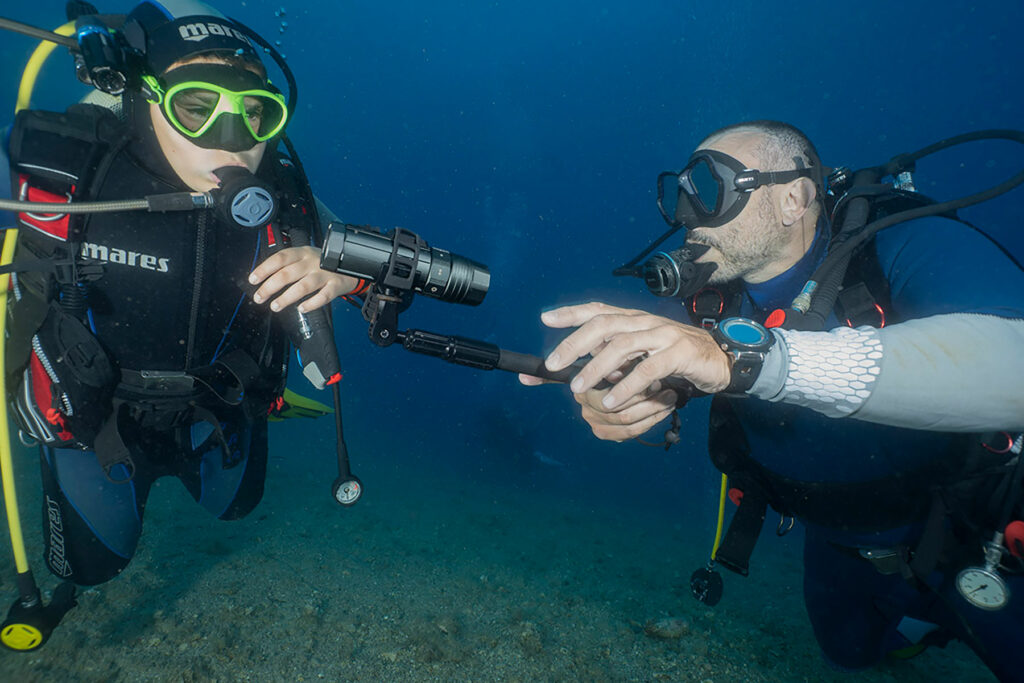We first encountered Paralenz a few years ago in Copenhagen when we traveled to Denmark to visit the company. In 2017, it introduced the first camera designed specifically for the underwater market. During several dives, we tested various Paralenz models, appreciating their ease of use and compactness. We even mounted them comfortably on our masks, taking them to various depths.
Our experience with Paralenz

From its first model, Paralenz made significant advancements up to the release of its second generation, the Vaquita.
The Vaquita kit includes the camera, a USB cable, a universal clip mount, a lanyard, and a protective bag. We added some accessories, such as a mask mount and a telescopic extension pole of 180 cm.
The Vaquita feels sturdy and compact to the touch. Its features reveal a concentration of technology in a small cylinder measuring 12 x 4 cm, equipped with GPS, pressure, conductivity, temperature sensors, an accelerometer, gyroscope, and a microphone.
We decided to test it with and without additional lights to assess the functionality of the DCC, or rather, the auto-DCC (Depth-Controlled Color Correction), an intelligent color correction that automatically adjusts white balance based on diving depth. We always kept the DCC active and were impressed by its performance, allowing us to dive with an extremely lightweight kit without needing additional lights. Only during night dives did we deactivate the DCC to capture the natural colors provided by underwater torches.
The command dial is well-designed and larger than its predecessor, making it easily controllable even with gloves on. The nearly one-inch OLED display keeps settings and the shooting scene readily visible.
Vaquita vs GoPro: David vs Goliath
Paralenz positioned itself as an original product alongside action cams and underwater cameras. It might be tempting to compare it with GoPro, but they are two completely different solutions. Remember, Vaquita is inherently an underwater camera, whereas GoPro is adapted for underwater use and requires a housing, filters, lights, and arms for deep diving.
With its automatic color balancing software, Paralenz doesn’t need filters.
Paralenz declares bankruptcy
The Danish company, which had 39 employees, was put into liquidation on October 18, 2022.
Why did Paralenz fail?
Unfortunately, despite years of collaboration, we were not notified of any problems by Paralenz and only learned of the bankruptcy when our emails started bouncing back.
The first camera, originally called “Octospot,” was launched as a Kickstarter-funded project in July 2016, where it reached its funding goal in less than 10 hours before being brought to market at the end of 2017.
Perhaps everything was too fast for a technologically advanced product with huge development costs in a market that might have been too small, fast-paced, and challenging.
Without the possibility of direct dialogue, we can only speculate about the potential reasons for failure:
- Overestimated market: the global diving community is a very small, demanding, and fragmented niche.
- Pricing: the cost of a Paralenz was always significantly higher than that of GoPro and not even comparable to emerging Chinese models of decent quality.
- Business model: after attempting direct sales, likely with poor results, Paralenz tried leasing through selected specialized centers, possibly leading to a significant expenditure of energy and resources.
- Communication: Paralenz failed to effectively communicate its product advantages, likely due to limited investment in marketing.
- Design: despite many product strengths, there were features that limited sales, such as the very small one-inch display.
- Development costs: in terms of product, Paralenz always had to catch up with necessary technological updates, which were accompanied by equally necessary software developments for its proprietary camera management app.
It’s sad to see another failure in a challenging sector that leaves little room for the development of truly interesting projects like Paralenz.
